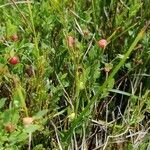A small shrub. It grows 10-20 cm high. The branches are angular and they remain green for several years. It has rhizomes that form shoots along their length. It loses its leaves during the year. The leaves are about 1 cm long. They are bright green on both sides. There are fine teeth around the edge. The flowers occur singly in the axils of the leaves. They are small and urn shaped. They are pale pink. The fruit are bright coral red berries. They are 5 mm across. They are tart but edible.

